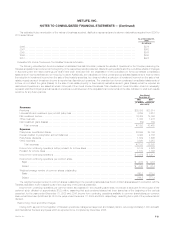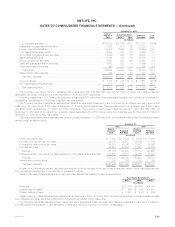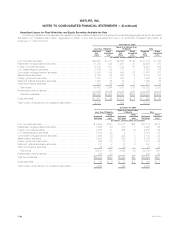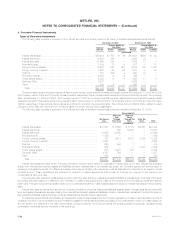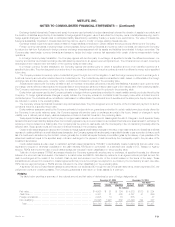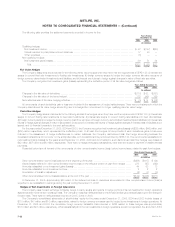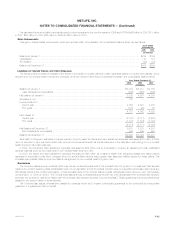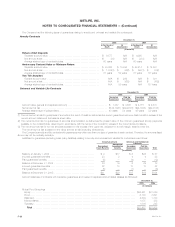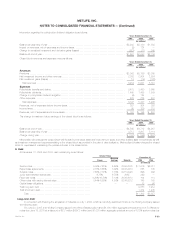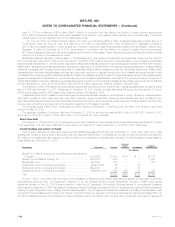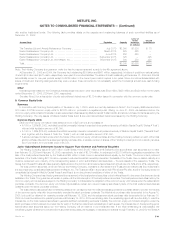MetLife 2005 Annual Report Download - page 93
Download and view the complete annual report
Please find page 93 of the 2005 MetLife annual report below. You can navigate through the pages in the report by either clicking on the pages listed below, or by using the keyword search tool below to find specific information within the annual report.
METLIFE, INC.
NOTES TO CONSOLIDATED FINANCIAL STATEMENTS — (Continued)
Exchange-traded interest rate (Treasury and swap) futures are used primarily to hedge mismatches between the duration of assets in a portfolio and
the duration of liabilities supported by those assets, to hedge against changes in value of securities the Company owns or anticipates acquiring, and to
hedge against changes in interest rates on anticipated liability issuances by replicating Treasury or swap curve performance. The value of interest rate
futures is substantially impacted in interest rates and they can be used to modify or hedge existing interest rate risk.
Exchange-traded equity futures are used primarily to hedge liabilities embedded in certain variable annuity products offered by the Company.
Foreign currency derivatives, including foreign currency swaps, foreign currency forwards and currency option contracts, are used by the Company
to reduce the risk from fluctuations in foreign currency exchange rates associated with its assets and liabilities denominated in foreign currencies. The
Company also uses foreign currency forwards and swaps to hedge the foreign currency risk associated with certain of its net investments in foreign
operations.
In a foreign currency swap transaction, the Company agrees with another party to exchange, at specified intervals, the difference between one
currency and another at a forward exchange rate calculated by reference to an agreed upon principal amount. The principal amount of each currency is
exchanged at the inception and termination of the currency swap by each party.
In a foreign currency forward transaction, the Company agrees with another party to deliver a specified amount of an identified currency at a
specified future date. The price is agreed upon at the time of the contract and payment for such a contract is made in a different currency at the specified
future date.
The Company enters into currency option contracts that give it the right, but not the obligation, to sell the foreign currency amount in exchange for a
functional currency amount within a limited time at a contracted price. The contracts may also be net settled in cash, based on differentials in the foreign
exchange rate and the strike price. Currency option contracts are included in options in the preceding table.
Swaptions are used by the Company primarily to sell, or monetize, embedded call options in its fixed rate liabilities. A swaption is an option to enter
into a swap with an effective date equal to the exercise date of the embedded call and a maturity date equal to the maturity date of the underlying liability.
The Company receives a premium for entering into the swaption. Swaptions are included in options in the preceding table.
Equity index options are used by the Company primarily to hedge minimum guarantees embedded in certain variable annuity products offered by the
Company. To hedge against adverse changes in equity indices, the Company enters into contracts to sell the equity index within a limited time at a
contracted price. The contracts will be net settled in cash based on differentials in the indices at time of exercise and the strike price. Equity index options
are included in options in the preceding table.
The Company enters into financial forwards to buy and sell securities. The price is agreed upon at the time of the contract and payment for such a
contract is made at a specified future date.
Equity variance swaps are used by the Company primarily to hedge minimum guarantees embedded in certain variable annuity products offered by
the Company. In an equity variance swap, the Company agrees with another party to exchange amounts in the future, based on changes in equity
volatility over a defined period. Equity variance swaps are included in financial forwards in the preceding table.
Swap spread locks are used by the Company to hedge invested assets on an economic basis against the risk of changes in credit spreads. Swap
spread locks are forward starting swaps where the Company agrees to pay a coupon based on a predetermined reference swap spread in exchange for
receiving a coupon based on a floating rate. The Company has the option to cash settle with the counterparty in lieu of maintaining the swap after the
effective date. Swap spread locks are included in financial forwards in the preceding table.
Certain credit default swaps are used by the Company to hedge against credit-related changes in the value of its investments and to diversify its credit risk
exposure in certain portfolios. In a credit default swap transaction, the Company agrees with another party, at specified intervals, to pay a premium to insure credit
risk. If a credit event, as defined by the contract, occurs, generally the contract will require the swap to be settled gross by the delivery of par quantities of the
referenced investment equal to the specified swap notional in exchange for the payment of cash amounts by the counterparty equal to the par value of the
investment surrendered.
Credit default swaps are also used in replication synthetic asset transactions (‘‘RSATs’’) to synthetically create investments that are either more
expensive to acquire or otherwise unavailable in the cash markets. RSATs are a combination of a derivative and usually a U.S. Treasury or Agency
security. RSATs that involve the use of credit default swaps are included in such classification in the preceding table.
Total rate of return swaps (‘‘TRRs’’) are swaps whereby the Company agrees with another party to exchange, at specified intervals, the difference
between the economic risk and reward of an asset or a market index and LIBOR, calculated by reference to an agreed notional principal amount. No
cash is exchanged at the outset of the contract. Cash is paid and received over the life of the contract based on the terms of the swap. These
transactions are entered into pursuant to master agreements that provide for a single net payment to be made by the counterparty at each due date.
TRRs can be used as hedges or RSATs and are included in the other classification in the preceding table.
A synthetic GIC is a contract that simulates the performance of a traditional GIC through the use of financial instruments. Under a synthetic GIC, the
policyholder owns the underlying assets. The Company guarantees a rate return on those assets for a premium.
Hedging
The table below provides a summary of the notional amount and fair value of derivatives by type of hedge designation at:
December 31, 2005 December 31, 2004
Fair Value Fair Value
Notional Notional
Amount Assets Liabilities Amount Assets Liabilities
(In millions)
Fair value****************************************************** $ 4,506 $ 51 $ 104 $ 4,879 $173 $ 234
Cash flow ***************************************************** 8,301 31 505 8,787 41 689
Foreign operations ********************************************** 2,005 13 70 535 — 47
Non-qualifying************************************************** 79,528 1,928 502 27,493 324 437
Total******************************************************** $94,340 $2,023 $1,181 $41,694 $538 $1,407
MetLife, Inc. F-31


